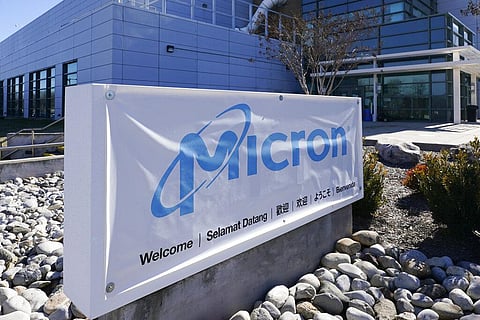

Micron Technology's proposed $2.7 billion chip testing and packaging plant in India has an undeniable Chinese trigger.
At least three factors seem to have influenced the $30.8 billion memory chipmaker to choose India, with firm support from Washington.
First, Micron is facing a partial ban in China.
Second, the US government's latest funding package for chipmakers reportedly comes with restrictions on doing business in China.
Lastly, Micron itself is facing a financial downturn, and given the incoming revenue hit from China, a market like India opens up fresh opportunities.
Finally, the timing of the announcement also serves a dual purpose.
One, Prime Minister Narendra Modi's first state visit to the US needed to show some big-ticket deals like the Micron investment, which incidentally also showcased the US' commitment to China-plus-one strategy.
Prior to Micron's partial ban, China had not taken any specific actions to counter the increasing US restrictions including a series of export controls and tech sanctions essentially preventing US companies from selling high-end chips and technologies to China. But in May, the Cybersecurity Administration of China claimed that Micron had failed its security review and barred domestic firms from purchasing Micron's products.
Initially, the revenue hit was estimated to be in low-single to high-single digit percentage. But early this month in an SEC filing, Micron warned of a bigger blow. The company now believes half of its revenue from China-headquartered firms will be impacted, equating to a low-double-digit percentage of its total revenue.
Micron's revenue from companies based in mainland China and Hong Kong, including direct sales and indirect sales, accounts for about a quarter of its total revenue. Micron said the conclusion by the Chinese regulator continues to remain uncertain and fluid, yet it vowed to invest $603.8 million in its chip packaging facility in the Chinese city of Xian.
Micron primarily makes two products: NAND, which doesn't need power to retain data like a portable flash drive, and DRAM, which must be powered on to hold data. Interestingly, their production is dominated by just three companies including Micron and two South Korean companies Samsung, and SK Hynix. Together, they account for over 90% of the global market share for DRAM chips and over 60% for NAND chips. It'll be interesting to see how the dispute over Micron evolves and if South Korea, a US ally, will pitch in to fill the gap left by Micron's exclusion in China or not.
Meanwhile, Micron's proposed Indian investment plans also come at a time when the company is facing a financial slowdown. Just last December, it announced 10% workforce reduction, besides other cost-cutting measures including suspension of employee bonuses and trimming of executive salaries to deal with a market demand-supply mismatch.
The Boise, Idaho-based company has about 48,000 employees across 38 sites in North America, Europe and Asia including one office in Bengaluru and two offices in Hyderabad. It has 11 manufacturing sites across the world, but none in India until now. The proposed Assembly Testing Marking and Packaging (ATMP) plant will also be India's first such plant in the high-end semiconductor fabrication ecosystem.
The company, however, said the austerity measures won't upset its investment plans. In fact, last year it announced a $100-billion investment plan to set up the US' largest semiconductor fabrication facility in Clay, New York. The proposed $100-billion megafab is an attempt to increase American-made DRAM production to 40% of the company's global output over the next decade.
Micron will avail over $5.5 billion federal incentives besides grants and tax credits from the CHIPS and Science Act. CHIPS, or Creating Helpful Incentives to Produce Semiconductors for America Act, introduced in August 2022, offers $52 billion of the $280-billion funding, and is a federal government initiative to revitalize domestic semiconductor manufacturing, where the US lags behind Taiwan and China.
Interestingly, those availing incentives from CHIPS Act face restrictions on how much capital they can spend on developing advanced factories in China or producing chips for the American market. Reportedly, companies can expand existing chip production facilities in China only if the output is intended for the Chinese market alone.
The Covid-19 led supply-chain disruptions was a wake-up call for all countries, and if there's one thing that every economy wanted to gain self-sufficiency in, it's in semiconductor chips, given their indispensable usage. Countries have been on an incentive-offering spree since then. If the US announced an eye-popping $280-billion funding package, the EU matched it with a euro 45-billion EU Chips Act. India, which meets all of its semiconductor needs currently through imports, announced a Rs 76,000-crore funding package.
The competition to attract chipmakers is so fierce that it's not just countries with little or no chipmaking experience that entered the fray. Even countries like Taiwan, the global hub for chip manufacturing, are unwilling to be easy, passing fresh laws offering incentives to local chipmakers to keep R&D within its territory. Taiwan has a near monopoly when it comes to chipmaking, yet the fact that its government finds the need to sustain incentives despite decades of handholding chipmakers confirms both the need and urgency to do so.